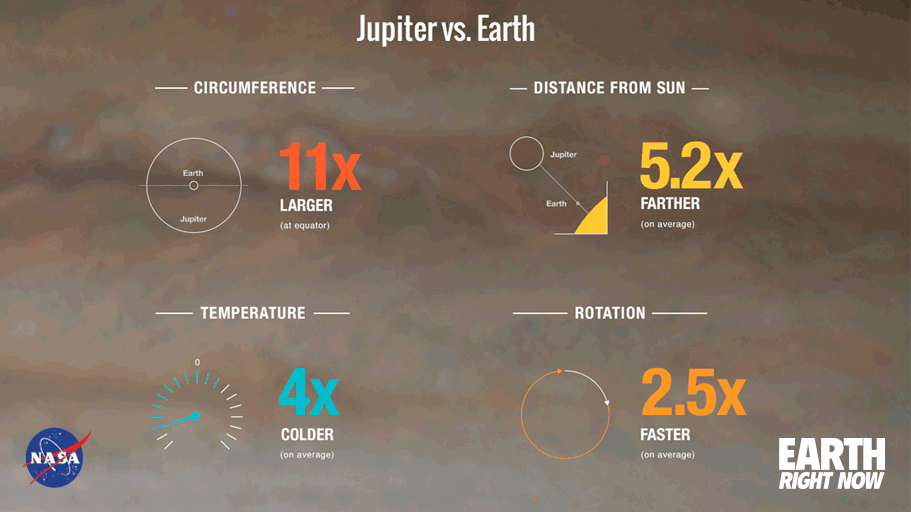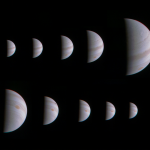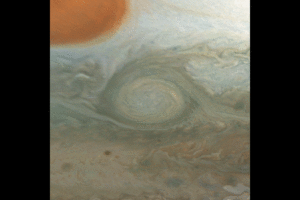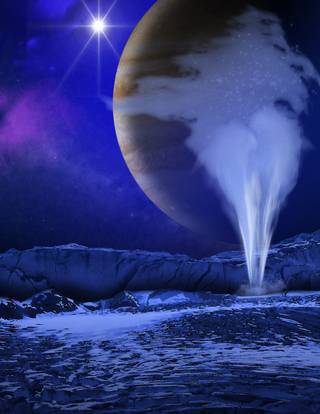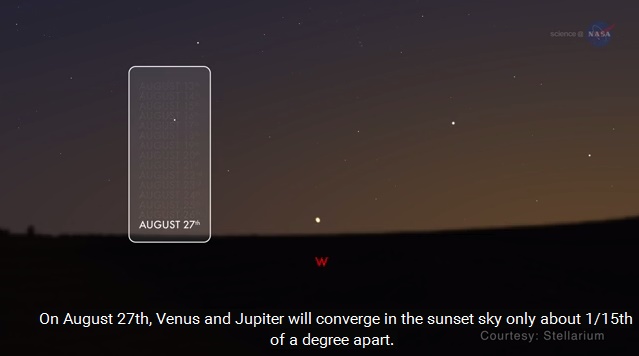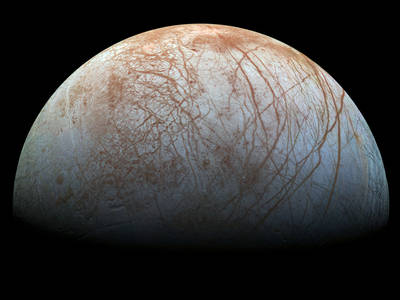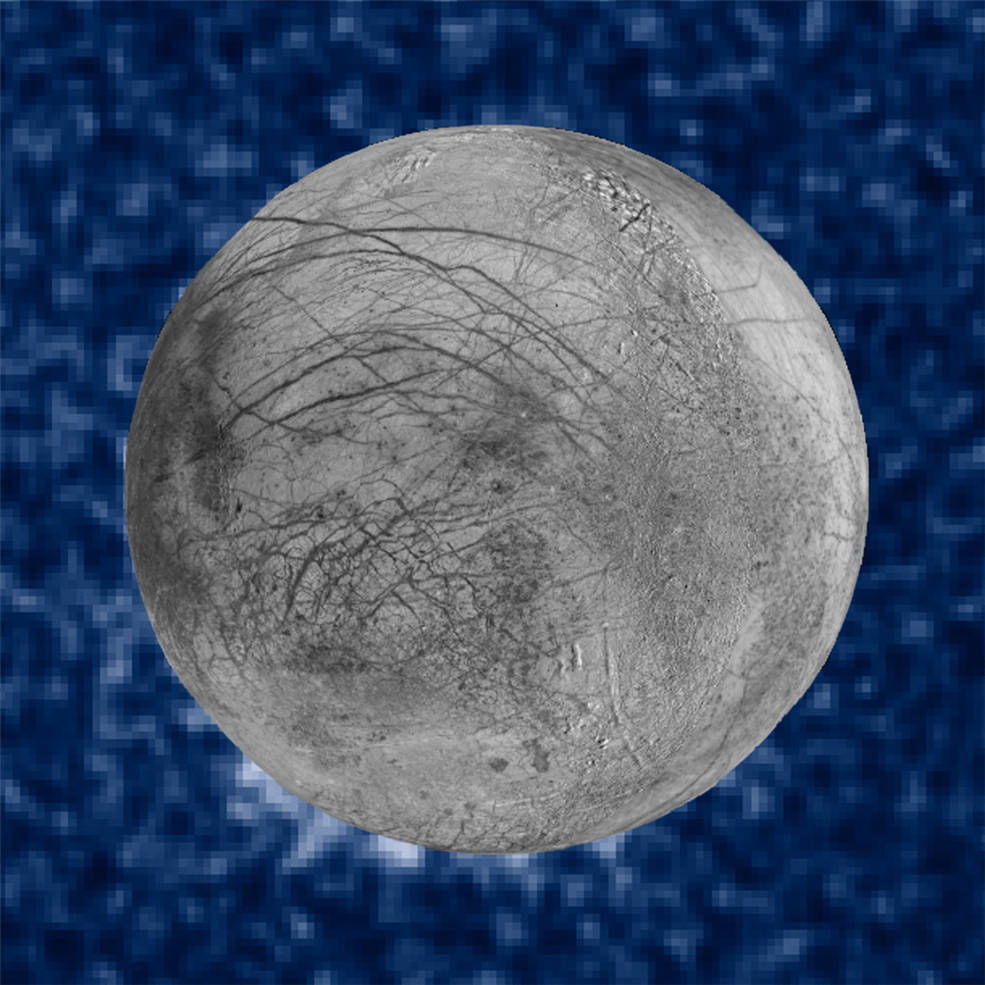訳者注
現時点で知りえている木星の情報で、地球と比較した一覧が公開されました。
まずはNASAのオリジナル(少し長いですが)を掲載し、後半に日本語訳を付けました。
NASAが公開した木星と地球との比較

Learning more about what Jupiter is made of and how it works will tell us more about the rest of the solar system and our own planet, Earth.
Giant Discoveries Ahead
Juno is poised to tell us about Jupiter’s makeup, findings that could unlock mysteries of the solar system.
After traveling 1.7 billion miles, NASA’s Juno spacecraft moved into orbit around Jupiter and its real work begins. The gas giant is so big that everything else in our solar system (except the sun, of course) could fit inside. Learning what Jupiter is made of and how it works will tell us more about the rest of the solar system and our own planet, Earth.
Jupiter vs. Earth
Circumference
11x larger (at equator)
Distance from Sun
5.2x farther (on average)
Temperature
4x colder (on average)
Rotation
2.5x faster (on average)
“We’re starting to realize Jupiter might be the key to our existence”
Dr. Scott Bolton, Lead Scientific Investigator for the Juno Mission
A Look at Atmospheres
JUPITER
Thermosphere
200 – 600 mi
Temperatures can reach 1,340° F in the thermosphere.
Juno’s instruments will collect data that researchers will use to better understand Jupiter’s auroras and compare them to the ones we see on Earth.
Stratosphere
30 – 200 mi
Pressure at the upper edge of the stratosphere equals one-thousandth that at Earth’s surface.
This layer hosts a haze of hydrocarbons and temperatures range from 260° F to -150° F.
Troposphere
-60 – 30 mi
White, whispy clouds of ammonia, ammonium hydrosulfide and water form the distinctive red and white bands in Jupiter’s troposphere.
Jupiter has no solid surface; the Jovian altitudes are relative to where the pressure is equal to Earth at sea level. Jupiter’s weather extends to where the pressure is much greater.
JUPITER & EARTH (middle bubbles)
Thermosphere
On both Earth and Jupiter, the thermosphere is warmed by the sun. Jupiter’s is also heated by the planet’s magnetosphere, a natural particle accelerator powered by Jupiter’s incredibly fast rotation.
Never-ending auroras glow at Jupiter’s poles, larger than Earth and hundreds of times more energetic.
Stratosphere
On Earth, the stratosphere is stable, with little water vapor. It’s where the ozone layer lies, protecting Earth from the sun’s ultraviolet radiation. Jupiter’s stratosphere contains water that scientists used the Herschel Space Observatory (a space telescope) to show came from the impact of Comet Shoemaker-Levy 9.
Troposphere
On both planets, this is where weather happens (and on Earth, it’s where we live). Nearly all Earth’s water vapor is found here and thus its clouds. On Jupiter, the weather is as supersized as the planet. Jupiter’s Great Red Spot has been swirling for hundreds of years, a storm bigger than Earth, with winds of 400 mph.
EARTH
Thermosphere
53 – 375 mi
Temperatures in the upper thermosphere range from about 932° F to 3,632° F or higher.
Mesosphere
31 – 53 mi
Meteors burn up in this layer. Earth’s mesosphere is responsive to small changes in atmospheric chemistry and composition, and it could provide more clues to how greenhouse gases contribute to climate change.
Stratosphere
10 – 31 mi
The ozone layer, which absorbs and scatters ultraviolet radiation from the sun, lies in Earth’s stratosphere.
Troposphere
1 – 10 mi
This part of Earth’s atmosphere is the most dense, and it’s where the jet stream is found.
Earth and Jupiter both experience lightning, however strikes on Jupiter can be hundreds of times more powerful.
“Juno will determine the relative abundance of water in Jupiter’s atmosphere. This will give us crucial information about how Jupiter and the entire solar system formed…this also addresses the question: Where did all the water come from on Earth?”
Robert Herman, research scientist at NASA’s Jet Propulsion Laboratory
Core Comparison
JUPITER
[ outer ] Molecular Hydrogen [ middle ] Metallic Hydrogen, Helium [ core ] Mixture of elements… Rock? Ice? (Juno will tell us whether the core is solid)The size and mass of Jupiter’s core are a mystery for Juno to solve. Temperatures are thought to be around 35,000° F. The pressure at the center of Jupiter is nearly 40 million times the pressure at sea level on Earth.
EARTH
[ outer ] Liquid Iron[ core ] Solid Iron
Earth’s iron core is smaller than our moon and is about 10,800° F – about twice as hot as the surface of the sun. The pressure in the center of Earth is about 4 million times the pressure at sea level.
“We’re using the techniques developed for Jupiter science and applying them to Earth.”
Dr. Brian Drouin, atmospheric scientist at NASA’S Jet Propulsion Laboratory
Drouin is working with Paul Steffes, a member of the Juno science team. Steffe’s lab at Georgia Tech helped test the conditions Juno’s microwave radiometer will encounter. The instrument will measure how much water is at Jupiter and how it moves beneath the clouds, based on how radio waves there behave, just as signals such as GPS are modified by Earth’s atmospheric water.
So, studying Jupiter’s water can improve our understanding of Earth’s water. “On Earth, our GPS signal is so precise we have to improve our understanding of the properties of water to fully utilize the signal’s potential for weather forecasting,” Drouin said.
日本語訳
木星について学ぶことで、太陽系でまだ知らないことや、地球自身についても、理解を深めることができます。
この先にある大発見とは
木星探査機ジュノーは木星の成り立ちや、太陽系についての様々な謎を解き明かしてくれるでしょう。
17億マイルを飛行した後、NASAの木星探査機ジュノーは、木星の軌道に到達し、実際の観測が開始されました。巨大なガス惑星(太陽を除いてですが)である木星は、私たちの太陽系の内部にある他のどの惑星よりも大きな惑星です。木星の成り立ちや内部構成、挙動などを調べることが、太陽系や、地球自身についての詳細が明らかになることでもあるのです。
木星と地球
大きさ
木星が地球の11倍 (赤道で比較)
太陽からの距離
木星が地球より5.2倍遠い (軌道の平均距離)
温度
木星が地球より4倍寒い (平均気温)
回転速度
木星が地球より2.5倍速い
「真の姿の木星を理解することは、私たちの存在の謎を解くカギとなるでしょう。今、それが始まるのです。」と研究責任者であるスコット・ボルトンが語っています。
大気
木星
熱圏:200から600マイル
気温は熱圏で1340°Fに到達します。
ジュノーの観測機器で木星のオーロラを観測し、そのデータにより地球上でのオーロラと比較するなど分析することができます。
成層圏:30から200マイル
成層圏上部の気圧は、地球の1000分の1です。
この層には、炭化水素のヘイズがあり、温度は260°Fから-150°Fの範囲です。
対流圏:-60から30マイル
木星の対流圏では独特の赤と白の帯があります。白い部分は、アンモニア、硫化水素アンモニウムの雲と水です。。
木星には、固体の表面がありません。木星高度は、地球の海面の気圧に換算して表します。木星の気象現象は、圧力が非常に大きい場合にも及んでいます。
